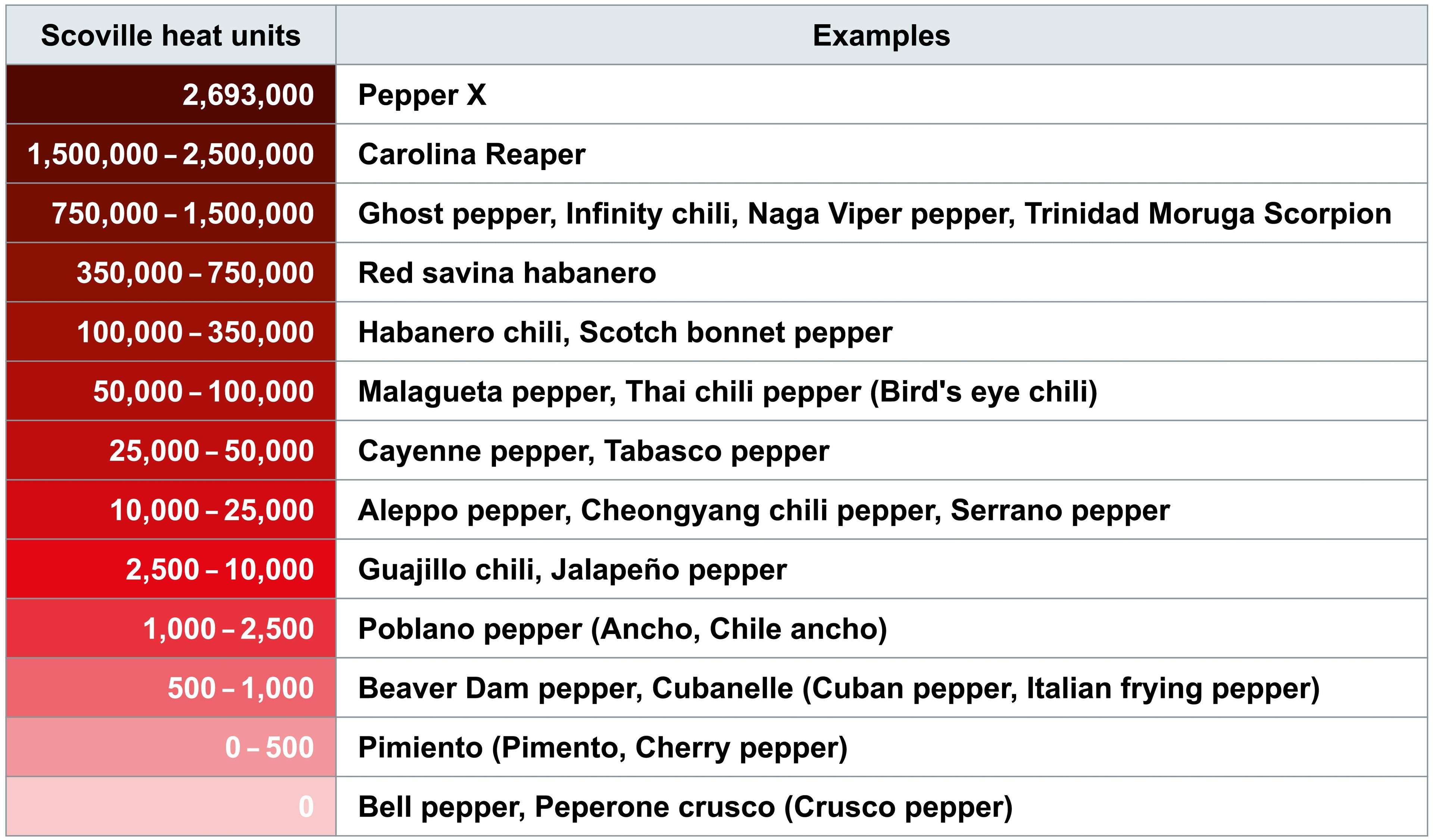
If you’ve ever bitten into a pepper and instantly regretted your life choices, you’ve already experienced the power of the Scoville Scale—whether you knew it or not. Developed in 1912 by Wilbur Scoville, this scale measures the heat level of chili peppers and spicy foods in Scoville Heat Units (SHUs). It’s essentially the pepper heat scale that helps spice lovers (and skeptics) know exactly what they’re getting into. The Scoville rating tells you how much sugar water is needed to neutralize the heat of a pepper. The higher the number, the more heat—and in some cases, pain—you’re signing up for.
🫑 Mild (0 – 2,500 SHU)
At the bottom of the Scoville chart are the bell peppers, which have 0 Scoville Heat Units. They provide sweet, crisp flavor with absolutely no heat — perfect for salads, stuffing, or grilling. Next up are Pimiento and Cherry peppers (0–500 SHU), which add a gentle warmth but remain very mild.
Between 500–2,500 SHU, you’ll find peppers like Cubanelle and Beaver Dam, offering just a hint of spice — enough to wake up a dish without overwhelming it. Poblano (Ancho) peppers (1,000–2,500 SHU) sit at the upper end of this mild range; they’re rich and smoky, and when dried, become the beloved “Ancho chiles” used in many Mexican sauces.
🌶️ Medium (2,500 – 25,000 SHU)
At the mild end of the Scoville chart, you’ll find the bell pepper, which has a Scoville rating of zero. It offers all the pepper flavor with none of the fire. Just above that, and probably the most widely recognized spicy peppers, is the jalapeño. Ranging from 2,500 to 8,000 SHUs, the jalapeño offers a moderate kick that’s approachable for most people. It’s the gateway pepper for many who are just beginning to explore the world of spice. Jalapeños are popular in salsas, poppers, and hot sauces, and they’re often the first name that comes to mind when people think about spicy food.
🌶️🌶️ Hot (25,000 – 100,000 SHU)
At this level, the heat becomes impossible to ignore. Peppers like the Cayenne and Tabasco fall within the 25,000 to 50,000 SHU range, offering a sharp, lingering spice that gives life to sauces and powders across the world. As you move toward the upper end of this range, you’ll find the Thai chili (Bird’s eye) and Malagueta pepper, which deliver a fiery sting that’s instantly recognizable in Southeast Asian and Brazilian cuisines. These small but powerful chilies bring not only heat but a clean, bright flavor that cuts through rich or oily dishes.
🔥 Very Hot (100,000 – 750,000 SHU)
At this point, the experience shifts from spicy to truly intense. Peppers like the Habanero and Scotch bonnet, ranging from 100,000 to 350,000 SHU, combine fruity, tropical flavors with a searing burn that can catch even seasoned chili lovers off guard. These varieties are staples in Caribbean and African dishes, where their sweetness and depth balance out savory and tangy flavors. Going higher, the Red Savina Habanero—which once held the title of the world’s hottest pepper—reaches up to 750,000 SHU. Its heat is fierce, with a complex, slightly smoky taste that makes it a favorite among hot sauce enthusiasts.
🌋 Superhot (750,000 – 2,693,000+ SHU)
This is where peppers cross into legendary status—the realm of extreme heat. The Ghost pepper (Bhut Jolokia), Infinity chili, Naga Viper, and Trinidad Moruga Scorpion all sit between 750,000 and over 1.5 million SHU. These superhots deliver a slow-building, almost overwhelming burn that can linger for minutes, making them popular in ultra-spicy sauces and food challenges rather than everyday cooking. Above them all reigns the Carolina Reaper, with a staggering range of 1.5 to 2.5 million SHU. Known for its wrinkled, sinister shape and slightly sweet flavor, it held the world record for years as the hottest pepper on Earth. But even the Reaper has been dethroned by Pepper X, the current record holder at a mind-blowing 2,693,000 SHU. Its intensity is so extreme that it’s rarely eaten on its own—used instead for specialized hot sauces or for those brave enough to test the limits of human spice tolerance.
